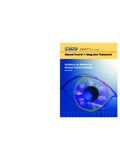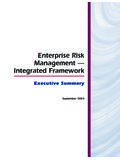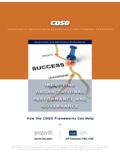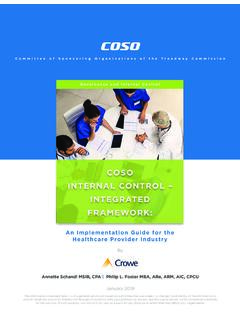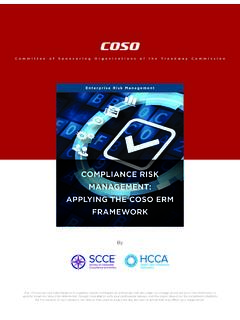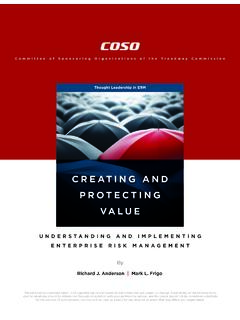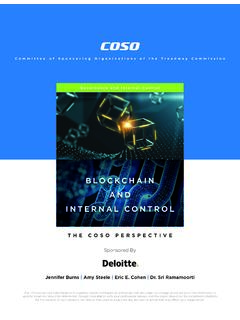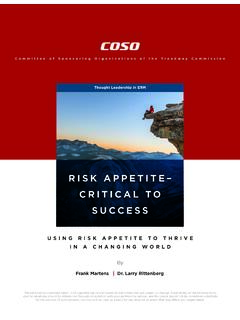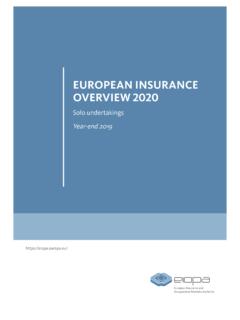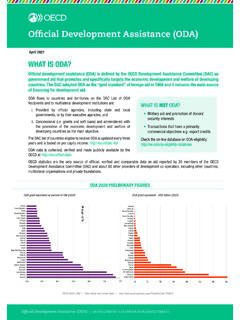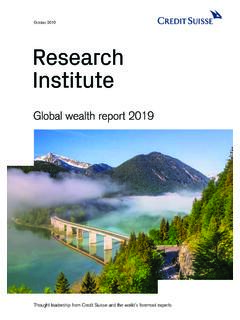Transcription of E nE R T p R i S E R i S k M A n A g E M E n T - COSO
1 Thought Leadership in ERM | Enterprise Risk Management Understanding and Communicating Risk Appetite | Larry Rittenberg and Frank MartensCommittee of Sponsoring Organizations of the Treadway CommissionThought Leadership in ERMU nderstanding andCommunicating Risk AppetiteEnTERpRiSE RiSkMAnAgEMEnT2 | Enterprise Risk Management Understanding and Communicating Risk Appetite | Thought Leadership in Larry Rittenberg Ernst & Young Professor of AccountingUniversity of Wisconsin-Madison School of Business Frank MartensDirector, PricewaterhouseCoopers (PwC) This project was commissioned by COSO, which is dedicated to providing thought leadership through the development of comprehensive frameworks and guidance on enterprise risk management, internal control, and fraud deterrence designed to improve organizational performance and governance and to reduce the extent of fraud in organizations.
2 COSO is a private sector initiative, jointly sponsored and funded by the following organizations: American accounting Association (AAA) American institute of CpAs (AICPA) Financial Executives international (FEI) The institute of Management Accountants (IMA) The institute of internal Auditors (IIA)COSO Board MembersDavid L. LandsittelCOSO ChairLarry E. RittenbergCOSO Chair - EmeritusCommittee of Sponsoring Organizationsof the Treadway F. ChambersThe Institute of Internal Auditors Mark S. Beasley/Douglas F.
3 PrawittAmerican accounting AssociationChuck E. LandesAmerican Institute of CPAs (AICPA)Marie n. HolleinFinancial Executives InternationalJeff C. ThomsonInstitute of Management AccountantsThought Leadership in ERMC ommittee of Sponsoring Organizations of the Treadway CommissionJanuary 2012 Research Commissioned byUnderstanding andCommunicating Risk AppetiteEnTERpRiSERiSkMAnAgEMEnTCopyrigh t 2012, The Committee of Sponsoring Organizations of the Treadway Commission (COSO).1 2 3 4 5 6 7 8 9 0 PIP 198765432 All Rights Reserved.
4 No part of this publication may be reproduced, redistributed, transmitted or displayed in any form or by any means without written permission. For information regarding licensing and reprint permissions please contact the American Institute of Certified Public Accountants, licensing and permissions agent for COSO copyrighted all inquiries to or to AICPA, Attn: Manager, Rights and Permissions, 220 Leigh Farm Rd., Durham, NC 27707. Telephone inquiries may be directed to Leadership in ERM | Enterprise Risk Management Understanding and Communicating Risk Appetite | iiiExecutive Summary 1 Overview 3 Risk Appetite Statements 6 Risk Appetite and Risk Tolerance 11 Developing Risk Appetite 15 Communicating Risk Appetite 18 Monitoring and Updating Risk Appetite 20 Roles 21 Summary of Considerations 23 About COSO 24 About the Authors 24 Content Outline Leadership in ERM | Enterprise Risk Management
5 Understanding and Communicating Risk Appetite | 1 Executive SummaryOrganizations encounter risk every day as they pursue theirobjectives. In conducting appropriate oversight, managementand the board must deal with a fundamental question: How much risk is acceptable in pursuing these objectives? Added to this, regulators and other oversight bodies are calling for better descriptions of organizations risk management processes, including oversight by the thought leadership document is one of a series of papers, sponsored by the Committee of Sponsoring Organizations of the Treadway Commission (COSO), to help organizations implement enterprise risk management (ERM).
6 The COSO document Enterprise Risk Management Integrated Framework explicitly states that organizations must embrace risk in pursuing their goals. The key is to understand how much risk they are willing to accept. Further, how should an organization decide how much risk it is willing to accept? To what extent should the risks accepted mirror stakeholders objectives and attitudes towards risk? How does an organization ensure that its units are operating within bounds that represent the organization s appetite for specific kinds of risk?
7 These questions are embodied in the notion of an entity s risk appetite. The objective of this paper is to help an organization its senior management, board, and key operating personnel to develop and communicate a clear understanding of its risk appetite, both to determine which objectives to pursue and to manage those objectives within the organization s appetite for organizations view risk appetite as the subject of interesting theoretical discussions about risk and risk management, but do not effectively integrate the concept into their strategic planning or day-to-day decision making.
8 We believe that discussions about applying risk appetite go well beyond theory, and that when properly communicated, risk appetite provides a boundary around the amount of risk an organization might pursue. An organization with an aggressive appetite for risk might set aggressive goals, while an organization that is risk-averse, with a low appetite for risk, might set conservative , when a board considers a strategy, it should determine whether that strategy aligns with the organization s risk appetite.
9 When properly communicated, risk appetite guides management in setting goals and making decisions so that the organization is more likely to achieve its goals and sustain its Risk Management and Decision MakingERM is not isolated from strategy, planning, or day-to-day decision making. Nor is it about compliance. ERM is part of an organization s culture, just as making decisions to attain objectives is part of an organization s fully embed ERM in an organization, decision makers must know how much risk is acceptable as they consider ways of accomplishing objectives, both for their organization and for their individual operations (division, department, etc.)
10 For example, one CEO recently reported that his organization needed to increase its risk appetite amid expectations that key measures of its profitability would fall or stagnate. A financial organization with a lower risk appetite might choose to avoid opportunities that are more risky, but offer greater returns. Finally, another organization with a high risk appetite might decide to procure natural resources from a volatile country where the total investment could be wiped out at the whim of the political leader.
